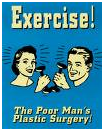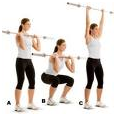“How To Get Maximum Weight Loss & Fitness Results In Minimum Time”

Yesterday, we talked about 3 great steps to get you started on your way to look and feel younger. Start off by setting realistic goals, don’t be too aggressive in the beginning, and remember to eat regular to lose weight and have energy. In case you missed yesterday’s post, here you go http://bit.ly/1800JI.
Today, we will expand on those beginning steps and look at what you can do next to obtain the body of your dreams!
 If your goal is fat-loss then your cardiovascular exercise should be low intensity. Your heart rate during cardio exercise should not exceed 50% to 70% of your maximum heart rate. Let me say that in another way: If you can’t hold a conversation during your (fat-loss) cardiovascular training – then your intensity is to high — bring it down. If the intensity of your exercise increases your heart rate beyond 70% (which can occur very easily if you are in poor shape), you start shifting from using body fat as your energy source to relying on glucose metabolism. Your personal trainer can supply you with a simple heart rate monitor you can wear during exercise so you always stay in your peak fat-burning range.
If your goal is fat-loss then your cardiovascular exercise should be low intensity. Your heart rate during cardio exercise should not exceed 50% to 70% of your maximum heart rate. Let me say that in another way: If you can’t hold a conversation during your (fat-loss) cardiovascular training – then your intensity is to high — bring it down. If the intensity of your exercise increases your heart rate beyond 70% (which can occur very easily if you are in poor shape), you start shifting from using body fat as your energy source to relying on glucose metabolism. Your personal trainer can supply you with a simple heart rate monitor you can wear during exercise so you always stay in your peak fat-burning range.
 Don’t waste your time working small muscles with isolated movements. If you don’t enjoy doing resistance training, or are pressed for time, concentrate on working the largest muscle groups with compound resistance movements. When I see overweight people doing wrist curls or lateral raises, I cringe knowing that they will not see results. It’s probably due to a lack of understanding about how their bodies work. Most people want to lose fat and tone and firm their bodies. The way to do that is to use resistance (weights or machines) to train the large muscle groups. Men should be concentrating on legs, chest and back. Women should concentrate more on their legs and back. The best exercises for legs are lunges or squats (a personal trainer can show you the proper form and then monitor you during the exercise) and leg press. The best chest exercise is bench press, and the best back exercise is the seated row. All of these are compound movements, which means, they incorporate multiple muscle groups, and compound movements are known for quickly increasing your metabolism.
Don’t waste your time working small muscles with isolated movements. If you don’t enjoy doing resistance training, or are pressed for time, concentrate on working the largest muscle groups with compound resistance movements. When I see overweight people doing wrist curls or lateral raises, I cringe knowing that they will not see results. It’s probably due to a lack of understanding about how their bodies work. Most people want to lose fat and tone and firm their bodies. The way to do that is to use resistance (weights or machines) to train the large muscle groups. Men should be concentrating on legs, chest and back. Women should concentrate more on their legs and back. The best exercises for legs are lunges or squats (a personal trainer can show you the proper form and then monitor you during the exercise) and leg press. The best chest exercise is bench press, and the best back exercise is the seated row. All of these are compound movements, which means, they incorporate multiple muscle groups, and compound movements are known for quickly increasing your metabolism.
 Always stretch. Stretching improves flexibility, blood flow, muscle recovery, low back pain and a host of other things. Additionally, stretching can prevent injury, make you sleep better and improve your performance in all sports. Always stretch, but be certain not to stretch cold muscles. You should always warm up before stretching. However, it is very important that you know how to stretch to achieve optimal fitness results. Never bounce, or aggressively push and pull a muscle beyond its natural range.
Always stretch. Stretching improves flexibility, blood flow, muscle recovery, low back pain and a host of other things. Additionally, stretching can prevent injury, make you sleep better and improve your performance in all sports. Always stretch, but be certain not to stretch cold muscles. You should always warm up before stretching. However, it is very important that you know how to stretch to achieve optimal fitness results. Never bounce, or aggressively push and pull a muscle beyond its natural range.
There you have it. Ten essential strategies for an effective weight loss and fitness program that will have you looking and feeling better than you have in years – maybe ever! I realize that starting (or re-starting) a productive and effective weight loss and fitness program is not easy. That’s why I encourage you to get help.
…because the hardest part is just getting started and sustaining your motivation until fitness becomes habitual. Once you develop the habit, which can take as little as thirty days, your whole life will change for the better.
Please visit my web site to initiate your subscription to my free health and fitness newsletter or to obtain any additional information you may need.
Thank you for reading my blog and taking an interest in your health and fitness.
P.S.—Would you like to work out with a Personal Trainer, without paying those crazy training fees? Check this out, http://bit.ly/4yPMOl.















